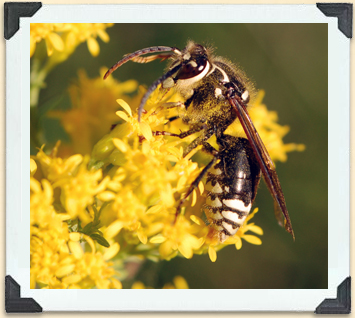What is a Bee?

Bald-faced hornets have a longer abdomen than other members of the yellowjacket family.
© Dreamstime
Bald-faced Hornets
Bald-faced hornets (Dolichovespula maculate) are not true hornets but rather, the largest type of yellowjacket. They measure up to 25 mm long, and are banded black and white.
Unlike most yellowjackets, bald-faced hornets usually make their nests high above the ground-at times as high as 20 m-often in trees, but sometimes on structures such as houses. Their nests are shaped like a football and can be as large as a basketball, with a paper-like covering made from wood fibres and saliva.
Bald-faced hornets feed on flower nectar and arthropods, including other yellowjackets, and sometimes on carrion.





